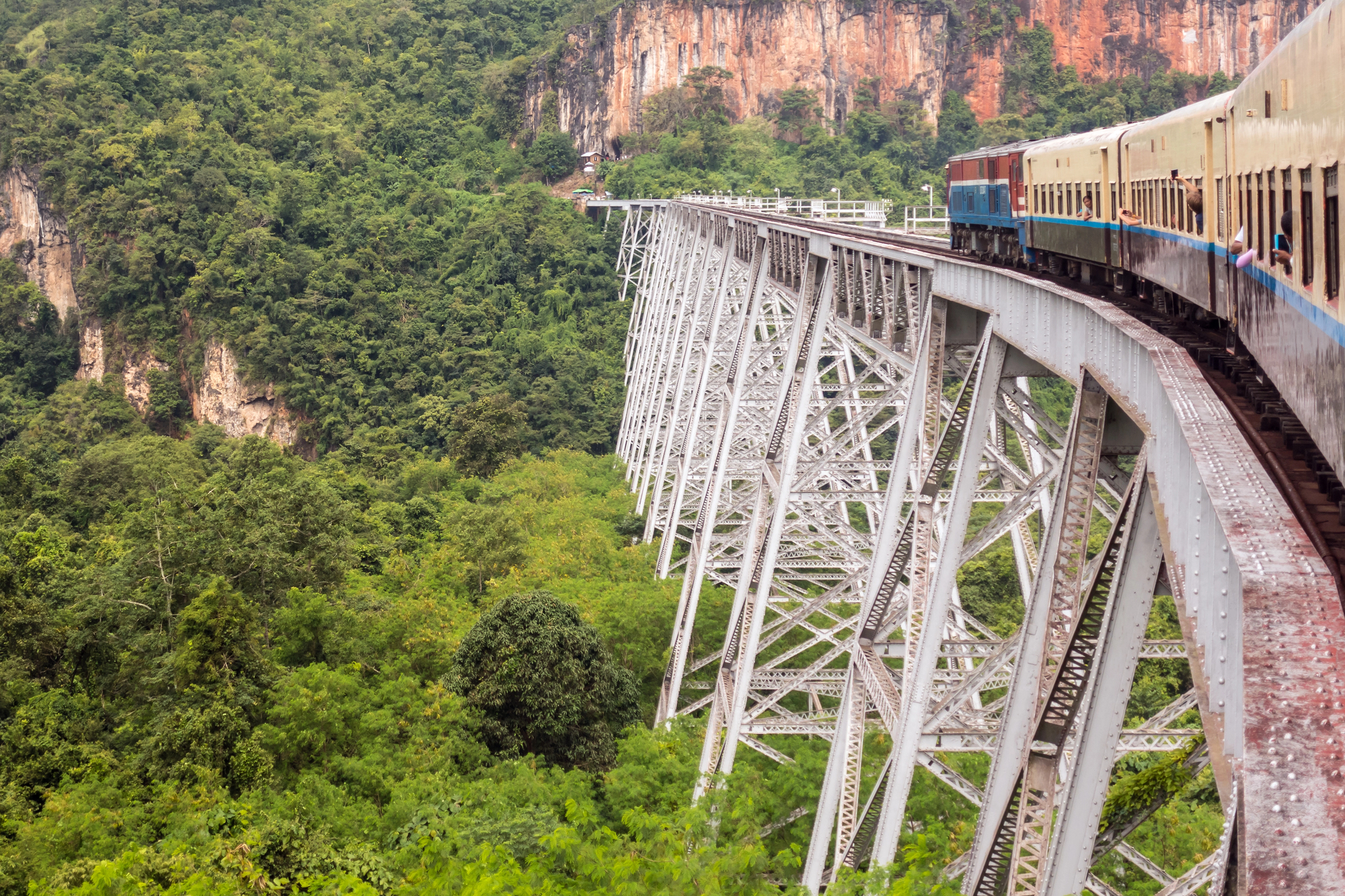The attack on the Gokteik Viaduct in Shan State, Myanmar, on August 24 may not resonate with many, being not particularly well-known outside of Myanmar. Yet the structure carries significant weight in the country’s history.
At the time of its construction 124 years ago, the viaduct was a marvel of logistics and engineering skill, and the longest railway trestle bridge in the world. An attempt to connect colonial Yangon with Kunming, China, the 102-meter-tall structure played witness to significant events in the recent history of Myanmar, including the nineteenth-century power plays between the British and the French in the Shan hills, and the dueling strategic objectives of Britain and Japan during the Second World War. It has seen the rise and fall of Burmese Communists, the Chinese Kuomintang, and Shan and Kachin revolutionary groups. The military junta, which seized power in an attempted military coup in Myanmar in February 2021, has accused the Ta-ang National Liberation Army of last month’s damage to the viaduct.
Myanmar’s cultural heritage, despite being less well known, is comparable to those of neighboring Thailand and Cambodia. The Shwedagon Pagoda in Yangon is said to predate both Bangkok’s Wat Arun and Cambodia’s Angkor Wat. Two sites in Myanmar have thus far officially been inscribed on UNESCO’s World Heritage List: a collection of three of the Pyu City States, whose people were among the first inhabitants of the region; and Bagan, which was the capital of the first unified kingdom that would later become Myanmar. Other sites, including the city of Mrauk-U, Inle Lake, and Shwedagon Pagoda, are on the tentative list and under consideration for inscription by the World Heritage Committee. As of July 2025, UNESCO has inscribed 1,248 sites across 170 countries, in an attempt to preserve and protect our shared heritage.
Heritage sites can contribute significantly to a nation’s economy through the tourism sector, but they are also an important source of historical knowledge and cultural identity. Beyond the architecture, these sites enshrine the beliefs, memories, and legacy of communities. They act as bridges connecting present locations to a people’s past and future, providing a sense of belonging and harboring lessons learned from history. The destruction of cultural heritage and representative sites, therefore, can have significant impacts on cultural memory and social cohesion.
Following the military coup of 2021 and the subsequent formation of the opposition National Unity Government (NUG), the NUG set up the Interim Board for Heritage Administration (IBHA) in June 2022. The IBHA has since established its own list of sites of importance for cultural heritage. For example, in January 2024, the IBHA named seven ancient cities in Mandalay Region as heritage sites, each of which is between 600 and 2,000 years old. In the days following the attack on the Gokteik Viaduct, the IBHA issued a statement blaming the junta for the damage. It also accused the Myanmar military of systematically destroying the country’s cultural heritage, pointing to 231 other attacks that have caused damage to heritage and religious structures from 2022 to 2024.
In January 2023, regime troops carried out an arson attack on an ancient village in Sagaing Region, torching homes and a monastery in villages neighboring Halin, one of the Pyu sites officially recognized by UNESCO. In the same month, the regime bulldozed the Neolithic archaeological site of Taungthaman in Mandalay, using the rubble from the Stone Age site to construct a road. Section 21 of Myanmar’s own 1998 Protection and Preservation of Cultural Heritage Regions Law prevents the excavation and building of roads in cultural heritage regions.
In December 2023, junta shelling destroyed the Mrauk-U Archaeological Museum, a key repository for Rakhine heritage. The Arakan Army, a Rakhine ethnic armed organization currently fighting for autonomy in Rakhine State, said that the junta deliberately targeted the museum, destroying priceless historical artifacts. Inside the museum were ancient stone pillars, coins, and inscriptions – historical objects dating back centuries.
The IBHA has also pointed to more recent attacks in July and August of this year, including the bombing of Lin Ta Lu monastery in Sagaing region and Chan Myae Su monastery in Mon State, attacks which also killed at least 25 people.

A train traversing the Gokteik viaduct in Shan State, Myanmar. (Depositphotos)
The targeting of sites of cultural importance has always been used as a tool of war; ancient rulers often destroyed the cities and temples of their rivals. It is not clear whether these attacks in Myanmar were intended to target the cultural heritage of ethnic or opposition groups, or are just a by-product of military attacks on the strategic positions of armed groups. However, both historically and currently, ethnic groups in Myanmar have had to endure the military government’s policy of Burmanization, which has been characterized by open discrimination against ethnic groups and their culture, languages, and religions, as well as the determination of exclusive – and Bamar-centered – historical narratives.
The Karen Human Rights Group (KHRG), for example, has previously reported on the central state’s removal of statues of the Karen ethnic group’s revolutionary hero Saw Ba U Gyi – while at the same time imposing symbols related to Burmese culture and history in ethnic areas. This appears to be in direct conflict with Myanmar’s Ethnic Rights Protection Law, which highlights the importance of preserving the historical and ancient heritage of ethnic groups.
While the UNESCO World Heritage Committee, established in 1977, can remove sites from its official list, it has little other power to impose any demands on a state. However, international instruments do exist for the punishment of destruction of property. The 1954 Hague Convention aims to protect cultural property in times of peace and war, while the Rome Statute, under which the International Criminal Court was founded, includes in its definition of war crimes the “extensive destruction and appropriation of property.” However, both the Rome Statute and the Second Protocol to the Hague Convention include clarifying clauses that give exceptions to incidents of military necessity.
But there are precedents. Ahmad al-Faqi al-Mahdi was found guilty of the war crime of intentionally directing attacks against religious and historic buildings in Timbuktu, Mali, in 2012. These included attacks on one listed World Heritage Site, but also nine other unlisted monuments of importance. And Pavle Strugar, a commander in the Yugoslav People’s Army, was found guilty in 2001 of destruction or damage to cultural and historical monuments in the heritage site Old Town in Dubrovnik, Croatia. Both served prison sentences.
Such cases are important in the Myanmar context as impunity has long been an issue in the military-led country, most famously involving the army’s abuses of the Rohingya people, but also historically against other ethnic groups. Such impunity continues today with cases of arbitrary detention, torture, and indiscriminate bombing. Impunity and inaction embolden offenders, and can also exacerbate divisions that pose major challenges to the future in Myanmar. The conflict, though it may not be ending soon, does appear to be shifting: a May 2024 update from the Special Advisory Council-Myanmar showed townships covering 86 percent of the country were not under stable junta control. Out of 51 townships with an international border, it found only five are currently under stable junta control or the control of junta-proxy militias. There are more than 40 ethnic armed organizations opposing the military junta in the current war, and while many gains have been made, many of these groups have different endgame goals and visions of politics beyond the conflict.
Despite cultural differences between and within nations, architecture, art, and other aspects of historical culture form a universal language that can help people and communities define their identity and heal from war. Where a loss of cultural identity is linked to a loss of social cohesion and harmony, leading to a detachment from common history and values, the preservation and celebration of cultural identity can have the opposite effects. Angkor was included on the World Heritage List in 1992 following three decades of revolution and conflict in Cambodia, marking an important step on that country’s road to recovery and national reconciliation. Similar examples around the world exist, including Stari Most in Bosnia and Herzegovina, and the mausoleums of Timbuktu.
Sites of cultural importance and cultural heritage in general can play a significant role in transitional justice and peacebuilding. In addition to inscribing sites onto their independent list, the IBHA also aims to educate local administrative officers on conservation techniques, and has coordinated with local armed groups to guard sites of importance and drive fighting away from protected areas. Though no nation would agree to put boots on the ground in defense of cultural heritage, there are other ways to help: governments, academic institutions, and the private sector can all play a role in supporting the preservation of heritage and history, through the creation of archives, funding for community-led curation initiatives, as well as – if needed – prosecutions and reconstruction efforts.
The destruction of sites representing history and diversity can have repercussions for generations to come; both the Myanmar military and ethnic armed organizations must be aware of this and do what they can to protect them. With limited capacity for armed groups to actively defend such sites, local organizations like the IBHA and KHRG, as well as local news outlets, are doing important work in at least recording incidents of cultural heritage destruction, helping to preserve history while also potentially laying important foundations for peacebuilding and post-conflict recovery. In the years to come, such records could prove to be important evidence of the unique customs, traditions, and histories of the ethnic groups of Myanmar.



























